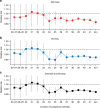Pregnancy duration and breast cancer risk
- PMID: 30353005
- PMCID: PMC6199327
- DOI: 10.1038/s41467-018-06748-3
Pregnancy duration and breast cancer risk
Abstract
Full-term pregnancies reduce a woman's long-term breast cancer risk, while abortions have been shown to have no effect. The precise minimal duration of pregnancy necessary to lower a woman's breast cancer risk is, however, unknown. Here we provide evidence which point to the protective effect of pregnancy on breast cancer risk arising precisely at the 34th pregnancy week. Using a cohort of 2.3 million Danish women, we found the reduction in breast cancer risk was not observed for pregnancies lasting 33 weeks or less, but restricted to those pregnancies lasting 34 weeks or longer. We further found that parity, socioeconomic status, and vital status of the child at birth did not explain the association, and also replicated our finding in data from 1.6 million women in Norway. We suggest that a distinct biological effect introduced around week 34 of pregnancy holds the key to understand pregnancy-associated breast cancer protection.
Conflict of interest statement
The authors declare no competing interests.
Figures


References
Publication types
MeSH terms
LinkOut - more resources
Full Text Sources
Medical

